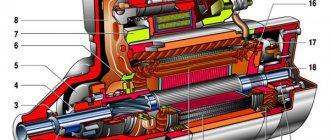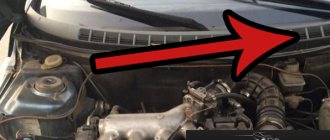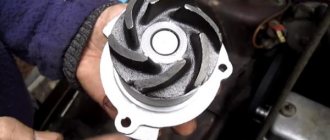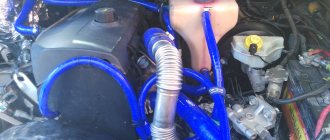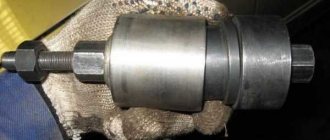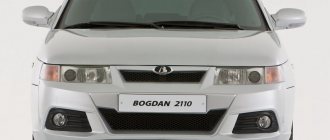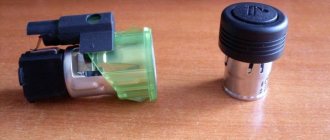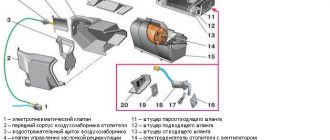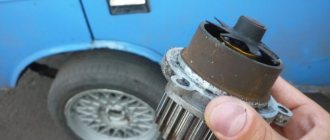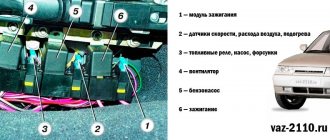Normal operation of a car engine is possible only if all its constituent elements, as well as the main components of the car, are in working condition. One of the main components of the ignition system in domestic “tens” is the starter device. You can learn more about how to repair a VAZ 2110 starter with your own hands and in what cases it needs to be carried out from this material.
How does the starter of the VAZ “Ten” work?
Domestic “tens” are equipped with a starter unit with number 5702.3708, which is essentially a DC electric motor. One of the main components of such a device is a traction relay, as well as a planetary gearbox. The motor is excited by the action of permanent magnets installed inside the unit structure. The body of the mechanism itself is made of steel; it is connected using two pins to the covers of the device.
Designation of the component elements of the device
Also, the design of the starter unit implies the presence of an armature and a stator. The armature is designed to carry out rotation in metal-ceramic liners, as a result of which the rotation is transmitted through a gearbox to the device drive. When the driver turns the key in the ignition, voltage from the car's battery is transferred to the relay windings. As a result of the influence of the magnetic field, the armature is first retracted, causing the gearbox gear to mesh with the flywheel. Accordingly, this leads to the closure of the contact bolts inside the structure.
Then the armature itself remains in the same state, it is fixed in this way with the help of a holding winding. When you turn the key in the ignition switch, this winding is de-energized. Ultimately, this contributes to the fact that the armature returns to its original position (the author of the video is Avtoelectrica HF).
Characteristic malfunctions of the mechanism
If the device stops working, the reasons may be:
- Low battery. Before repairing the VAZ 2110 starter, you need to make sure that the battery is fully charged and operational.
- The appearance of oxidation on the wires, as well as the terminals of the mechanism. As a result, the contacts can no longer transmit current, and therefore the operation of the starter device will be impossible. This malfunction also includes poor fastening of the wiring, in particular the lugs. In this case, in order to get rid of the malfunction, you will need to clean each contact, as well as the terminals. If during the diagnostics you notice that there are loose elements or clamps on the mechanism, then they should be secured as much as possible. In addition, the connecting components will need to be treated with Vaseline or grease, this will further prevent oxidation of the contacts.
- Failure of the traction relay. Due to the inoperability of this device, short circuits may occur in the unit, which will lead to a complete stop of the mechanism. A failed element will need to be replaced. The reason may lie in a broken electrical circuit.
- Failure of the traction winding - such a malfunction can also cause short circuits in the system.
- Failure of the contact part of the ignition switch. Such a malfunction, as a rule, cannot be repaired, therefore, when it occurs, the contact group must be replaced.
- Anchor failure. Its malfunction may manifest itself in the fact that this element cannot scroll as a result of complications during rotation. For more accurate diagnostics, this component should be dismantled and the efficiency of its rotation should be diagnosed. If the diagnostics confirm a faulty armature, then the device must be replaced (the author of the video is the stas di channel).
Main causes of malfunction
Minor or partial repairs will not always save the situation. But before removing the starter from the VAZ 2110, we recommend that you familiarize yourself with the main reasons for its failure, which serve as a reason for replacement.
- When turning the ignition key, a grinding noise occurs in the engine compartment. This is the cause of a faulty bendix or flywheel.
- Clicking noises are heard when turning the key. The reason is the solenoid relay, which needs to be replaced.
- The engine turns over with a friend. This indicates that the starter brushes are worn out.
Instructions for repairing and replacing the device
Replacing a VAZ 2110 starter and repairing it looks like this:
- Disconnect the battery and disconnect the wire plug from the relay. Dismantle the wire itself, which o.
- The starter mechanism should be disconnected from the engine; to do this, unscrew the nuts that secure it.
- If you are making a replacement, then at this stage the device can be dismantled and replaced with a new one. If you decide to repair, then move on.
- On the relay itself, unscrew the nut, and then disconnect the traction element from the screw. The relay is removed; to do this, you also need to unscrew the two clamps.
- Then the anchor is dismantled from the seat; to do this, the element should be slightly lifted up.
- Remove the pins, and then remove the starter cover. The cover is dismantled first with the drive and gear element, and then with the brush assembly and their retainer, which is located next to the commutator.
- Next, the gear is removed from the anchor shaft, and the anchor itself is then removed. Having done this, you can remove the gears from the gearbox. If they show signs of damage or defects, the gears should be replaced.
- The gear component is removed from the cover. Check the quality of the seal and replace it if necessary.
- Using a mandrel, it is necessary to dismantle the restrictive ring; it is located directly on the locking ring, after which the drive and other elements, including supports, levers and washers, are dismantled. Each of the elements, if necessary, must be replaced.
- After dismantling the brushes, you need to check them. If signs of wear are visible, the brushes are replaced. All failed components are replaced, and the starter is reassembled in the reverse order.
Replacing the unit
Now another question arises - how to disassemble it? There shouldn’t be any particular problems with this matter if you arm yourself with the instruction manual and also read our recommendations.
Arm yourself with a set of keys for 10, 13, 15 and 8 millimeters. Actually, you don’t really need anything else in terms of tools.
The sequence of dismantling and repair is as follows:
- Drive the car into the pit or lift it using a lift. You must have access to the underside of the car.
- If you have just arrived, give the engine some time to cool down. It is better to work with a cold engine.
- Remove the negative cables from the battery.
- First remove the protection and then the tin casing that protects your gearbox. To do this, you will need two keys - 8 and 10 millimeters.
- The power wire plug is removed from the starter. You just need to pull it towards yourself a little.
- Now take a 13 mm wrench and use it to unscrew the power wiring located on the solenoid relay.
- Place the loose wire aside and secure it with something temporarily so that it does not interfere with further repairs.
- The starter is attached to the gearbox housing with two nuts. They are easily loosened with a 15mm wrench. If you have problems unwinding, lubricate the fasteners with the almighty WD40.
- Dismantle.
- Now check the condition of the bushings on the gearbox housing.
- Make sure that the armature shaft is in good condition; when moving, there should be no play or jamming. If such defects occur, then it is recommended to immediately replace the bushings with new and high-quality ones.
- There are always two bushings. One is at the bottom of the starter, and the second is on the gearbox housing. The bushing on the starter can be changed without any problems, but difficulties may arise with the second one. To dismantle it, you need a special tool called a rubber. It is better to entrust the work to specialists from a service station.
- If the cause of the starter malfunction is the bendix or the solenoid relay, there is no need to call the experts for help.
- To remove the relay, unscrew the power wire, or rather its fastening, from the starter housing. You will need a key for 13.
- Using a size 8 wrench, remove the two bolts securing the relay to the starter housing. It is important to be careful here, because when removing the bolts, there is a spring in the relay that can spring back. Hold it with your hand when dismantling.
- Remove the relay piston from the rocker arm hook located on the bendix.
- Proceeding in reverse order, install a new relay.
- If you need to replace the bendix, then remove the solenoid relay, unscrew the two bolts with a 10mm wrench at the back of the starter. Now disconnect the starter housing from the front of the starter where the bendix, rotor and fork are located.
- Use a flathead screwdriver to pry up the plastic fork to remove it from the armature, and remove the armature itself and the bendix from the front of the body.
- Remove the retaining ring located on the tip of the armature and remove the desired bendix.
- The structure can be assembled in the reverse order, but the splines must first be lubricated with Litol.
- Test the new starter in place before beginning installation. To do this, connect the power terminals of the battery.
- The nuts responsible for fastening the terminals are tightened with a 13mm wrench. But it is not recommended to apply much force, since the terminals are made of copper. Clamping too hard will damage the threads, causing even more problems.
We figured out how to disassemble the starter on a VAZ 2110 and we can say that this procedure is not particularly simple, but it does not require mandatory execution by a professional auto mechanic.
The starter on the “ten” is somewhat capricious, but if you operate the car correctly, check the condition of the contacts, and also periodically flush the engine on the injection VAZ 2110, it can last a long time and reliably.
Starter repair for VAZ 2110, VAZ 2111, VAZ 2112
Welcome! A starter is a very necessary thing in a car; thanks to it, the engine of the car turns on and starts, but recently starters have begun to be counterfeited and made of poor quality, and therefore many car owners, when installing a new starter, after a very short period of time go back to the service center and replace it with a new one , although you don’t have to change it at all, but simply repair it thoroughly yourself and at the same time put lubricant in the gears, which is so little put at the factory where new starters for cars are made.
Note! To repair the starter, you will need to take from the following tools: Keys, namely wrenches, sockets, sockets, in addition, expansion pliers will be required and a screwdriver (It all depends on what exactly you will change in the car, if there is only one solenoid relay, for example, then In this case, you won’t need anything else except wrenches)!
Summary:
When should the starter be repaired? If your car stops starting or starts poorly, then this indicates that the starter may have become unusable, but besides it, the ignition switch can also cause problems and the car will not start or even the same wires, so it’s clear to say that it’s the starter it didn’t break so easily, but still the most common reasons are when something clicks when you turn the key and the car doesn’t start, or when the starter spins but does it very weakly and the engine cannot start due to this (In this case, the battery is also may be discharged), and the last thing is when, when you turn the key, you hear extraneous sounds (grinding of metal and the like) if you hear such sounds, then we do not recommend using the car in the near future, otherwise in the future you will need to change the crown of the flywheel You will have to remove the flywheel itself from the car to do this.
The starter doesn't turn over
There are many reasons why the starter does not work, but first of all you need to check the most common reasons why the engine will not start.
Checking contacts on the battery
Often the reason when the starter does not turn is due to loose terminals on the battery or their oxidation. It is enough just to clean the oxidized terminals from chemical reactions and tighten them with a force that will ensure reliable contact.
Battery discharge
Quite often, especially in winter, after a period of inactivity, the car’s battery may discharge, and thickened oil during parking will not allow the weak battery to rotate the crankshaft with the starter. You can check the battery with a regular multimeter; in winter its voltage should not be less than 12V, in summer not less than 11V. This voltage is not an indicator of the battery charge; at such values it is better to charge the battery.
Egnition lock
In some cases, the contact part of the ignition switch may fail. This is due to aging or poor quality parts. In this case, when turning the key, the contacts will not close to turn on the starter.
Winding break
If the winding on the stator or rotor of the starter breaks, the magnetic field that rotates the armature will not appear and the starter armature will not move.
How to repair the starter on a VAZ 2110-VAZ 2112?
Note! First, the starter is removed from the car and then checked for functionality. You can find all this information in the article entitled: “Replacing the starter on a VAZ”, but in addition, check out the video below, which talks in more detail about How can you check the removed starter for functionality?
Disassembly: 1) First, unscrew the nut indicated by the blue arrow and remove the wire behind it indicated by the green arrow, thus after this operation the solenoid relay can already be removed from the car and no wires will interfere with this (But regarding the removal of the relay, a little We’ll explain everything later, since there are still a couple of bolts to unscrew, but if you need to change it, then immediately skip all the points and read carefully point number 3 in which everything is described), now unscrew the two nuts (Indicated by red arrows ) tie rods that hold the stator and then disconnect it from the front cover.
2) Now remove the three planetary gears of the gearbox from the starter (All of them are indicated by arrows), but you can only have three or four of them, if you still find four gears, then first pry off the very central one with a screwdriver and then remove it , then the remaining three and when they are removed, check their condition; the gears should not have chips, scuffs, signs of corrosion or other damage, otherwise they are replaced with new ones.
Note! After removing all the gears, there will be one more single and large one, called the ring gear, it should also not have chips or other defects, it can be removed either separately, for this you just need to pry it off with a screwdriver (see large photo), or together with the drive shaft, drive lever and lever support, for this you need to pry it off with the same screwdriver, but not by the gear itself, but by the support (see small photo), if you suddenly completely removed the entire drive, then first of all inspect it and make sure that the teeth on the drive are not painted in any other color and that there are no nicks or deformations on them; minor defects are eliminated with a diamond file or an abrasive stone; if necessary, replace the entire drive or the entire starter with a new one!
3) Regarding the removal of the solenoid relay, it has two bolts that secure it, they are also indicated by red arrows, so if you want to remove it, then unscrew these bolts and then, carefully pulling the relay (indicated by the blue arrow), remove it from the starter and by the way, about checking it, connect an ohmmeter to the terminals of the traction relay and then press the armature inward all the way, while the ohmmeter readings should be close to zero, if this is the case for you, then the relay is working properly and does not require replacement.
4) Then take a wrench and a hammer and, using them, knock down the travel limiter ring (see photo 1, do not forget to place some kind of piece of wood or a piece of thick rubber under the drive so that it does not deform), as soon as the ring is knocked down, using a screwdriver, remove the other retaining ring from the groove and then remove it and then remove the travel stop ring from the shaft (see photo 2), then remove the drive from the shaft and when it is removed, use expanding pliers to pry up the retaining ring and its remove (see photo 3) and thereby you can disassemble the drive and replace the parts worn out in it, and finally, the remaining part with the shaft can also be disassembled if necessary, to do this, remove exactly the same retaining ring (see photo 4) and remove the thrust washer from the shaft, as well as the shaft support, and so on.
This is interesting: Adjusting the carburetor Java 638
5) Next, using a flat-head screwdriver, pry and thereby remove the front cover (It is indicated by a green arrow) from the stator and by the way, if when removing the stator the same central gear remains seated on the shaft, which is still indicated by the red arrow, then you remove it, Otherwise, you won’t be able to remove the cover, it will rest against this gear (Don’t forget to check the gear, if traces of deformation are found on it, then replace it with a new one).
6) And finally, unscrew the two screws securing the stator cover (see photo 1) and then remove it, as soon as the cover is removed, using a screwdriver, pry up the starter brush assembly (see photo 2), then remove the one located behind it the front shaft support (see photo 3) and the thrust washer as shown in the fourth photo and at the end, grasping the shaft (It is also indicated by an arrow for clarity), overcoming the force of the magnets, remove the armature from the stator and after removing it, inspect its commutator and winding , traces of charring and various kinds of deformations should not be found on the armature windings, otherwise the armature is replaced with a new one, but if everything is in order with the winding, then proceed to cleaning the armature commutator, namely, if it is very dirty, then using sandpaper (Nulyovka), clean it, then rinse the starter armature with water in which the detergent will be diluted and at the very end, when the work has already been done, clean the armature dry with a clean rag from water and dirt and blow it with compressed air (Compressed air can be supplied parts such as compressor, tire pump and so on).
Note! There is something else we wanted to warn you about: when the brush assembly is removed, check its brushes, the height of which must be at least 3.5 mm, and the brushes must not have damage or other types of deformation, except for the brushes of the gearbox part (These include all gears) and the drive with white spirit, in addition to all this, rinse and then you can begin to reassemble the starter and install it on the car!
Assembly: During assembly, apply grease to the gearbox parts, dip the drive in engine oil and wait until it drains from it, lubricate the bushings in which the armature and starter drive shafts rotate and also the screw splines of the drive with engine oil, if you removed the brushes to replace them, then they can be installed in their place using a special mandrel, or if it is not there, then proceed in the following way, namely, secure the brush assembly to the cover with two screws, then lubricate the end of the armature shaft with two drops of engine oil and insert everything (Four ) brushes, into the corresponding brush holders, but do not install the brush springs in their places and then put the brush assembly on the armature commutator, then use pliers to open the outer stops of the springs of all brushes (see photo 1), then insert the springs into these places (see . photo 2) and holding each spring separately (First one, then the second, and so on) there with a screwdriver (To prevent it from flying out), bend the spring stops with pliers, install the other springs in their places in the same way and insert the armature into the stator ( When you insert it, do everything carefully and try to ensure that the armature commutator does not get out of engagement with the brush assembly, otherwise you will have to re-install the brush assembly), while the brush assembly and cover should already be on the anchor, assemble all the remaining parts in the reverse order removal
Additional video: You can clearly see the starter repair procedure in the video below:
Note! The video above does not show the repair of the Bendix, also known as the drive, but only shows partial disassembly of the starter. For more details on how to remove and disassemble this drive, see another video, which is also located below:
Tens starter device
The VAZ 2110 is equipped with a mechanism model 5702.3708, which is a DC motor containing two main components: a traction two-winding relay; planetary reductor. This motor is excited by permanent magnets. They are attached from the inside of the starter housing, which is made of steel. The specified body is connected to the covers (fastening is done using two studs).
The starter design includes an armature and a stator. The armature shaft rotates in cermet liners, and from it the rotation goes through the planetary mechanism to the drive. When the starter starts, the car battery transmits voltage to the relay coils. The armature, experiencing the influence of a magnetic field, is retracted, after which the planetary gear gear engages with the flywheel, which causes the contact bolts in the device to close.
After this, the armature remains retracted, and its fastening is ensured solely by the holding winding. When the driver turns the key in the lock, de-energization of this winding is noted. This causes the anchor to take its initial position.
Operation of the VAZ 2110 family starter, faults and solutions Autosite
Technical characteristics of the starter for cars of the VAZ 2110 family Rated power, kW…………………………………………………………………………………..1.55 Current consumption at maximum power, no more , A………….375 Consumed
Technical characteristics of the starter for cars of the VAZ 2110 family Rated power, kW…………………………………………………………………………………..1.55 Current consumption at maximum power, no more than, A ………….375Current consumption in a braked state, no more than, A…………..700Current consumption at idle, no more, A…………………………….80
Features of the starter device type 57.3708 The starter type 57.3708 installed on VAZ 2110, VAZ 2111, VAZ 2112 cars (Fig. 7-15) is a direct current electric motor with excitation from permanent magnets, with a planetary gearbox and an electromagnetic two-winding traction relay. Covers 2, 6 and stator housing 3 are tightened with two studs. The armature shaft 23 rotates in two metal-ceramic liners installed in the cover 2 and support 21. Four permanent magnets 22 are fixed in the stator housing.
Rotation from the armature shaft 23 is transmitted to the drive shaft 14 through a planetary gearbox, which consists of a central gear 20, three planetary gears 10, a carrier 19 and an internal gear 18. Planetary gears rotate on needle bearings. The starter connection diagram type 57.3708 for VAZ 2110, VAZ 2111, VAZ 2112 cars is shown in Fig. 7-16. When the starter is turned on, the voltage from the battery is supplied through the ignition switch to both windings of the starter traction relay (retractor II and retainer I).
Checking the functionality of the VAZ 2110 starter - why doesn’t it turn?
Before we begin disassembling the starting system mechanism of interest to us, we should make sure that it does not work precisely because of its malfunction. The check is performed as follows:
- We turn the gear in the direction of rotation of the armature. It should not turn in the opposite direction. If such reverse rotation is present, this indicates a faulty starter.
- We check the ease of movement of the device coupling along the shaft (use a screwdriver). With a normally functioning mechanism, the coupling moves without the slightest difficulty.
Using the “lighter” wires and the battery, we analyze the serviceability of the starter. To do this, we connect the negative terminal (black wire) to the starter housing, and connect the traction relay through its control cable to the positive terminal (red wire).
In cases where the relay operates normally, the drive clutch extends and a characteristic click is heard. If it does not turn on, you will have to disassemble the starter and replace the traction device.
Also, the starter of a VAZ 2110 car does not turn when its anchor does not work. Checking the armature is done as follows: remove the cable from the relay (from its output); connect the specified cable to the contact bolt. If the armature is in good working order, its rotation frequency should be at least five thousand revolutions per minute. If the frequency is lower, the starter does not operate.
Doesn't it turn?
If the starter on an injection VAZ 2110 does not turn, there may be several reasons for this.
- The culprit is the solenoid relay. If you insert the key, turn it, the instrument panel lights up, the fuel pump turns on, but when you turn it further, the panel goes out and the starter does not turn on, you should check the solenoid relay. Make sure there is voltage in it. Try closing the starter, turning off the alarm, which can also cause problems. If everything works separately, but in the end the starter does not turn on, then the reason is in the solenoid relay. It needs to be replaced with new ones and the problem will disappear.
- Overrunning clutch does not work. You started a cold engine, drove a couple of tens of kilometers, stopped to get out for a couple of minutes, returned, and the starter clicks, but does not turn on your VAZ 2110. Only when the car cools down, you manage to start the engine. First of all, the overrunning clutch, or popularly Bendix, is to blame. Replace it with a geared analogue. Additionally, check the wires that go from the Bendix to the battery.
- There are no contacts. The starter starts, but it is very difficult, making a lot of clicks. If the situation repeats regularly, be sure to check your contacts. The terminals are probably oxidized. Cleaning didn't work? Then check the ground contact with the car body and the starter contacts. For them, oxidation is a natural phenomenon. Another way is to ask a friend to turn the key in the ignition, and then hit the relay with a hard object a couple of times. If the car starts, then the closing contacts are simply stuck. But here it is better to completely replace all the relays than to repair and disassemble the unit.
- The problem is in the immobilizer. It is not uncommon for the starter activation circuit on the injection VAZ 2110 to be disrupted due to the immobilizer. The engine may suddenly stall, the starter stops turning, and it is not possible to start it even with a push. The terminals are clean and the battery is charged. If the immobilizer is turned on, this may be the cause. Due to the protection being triggered, the engine does not respond. You will no longer be able to start the car, so call a tow truck and go to the nearest service station.
- Problematic injector. We have examined almost all starter problems characteristic of a carburetor engine. But today the “tens” are injection ones. They don’t really like low-quality fuel, which VAZ 2110 owners so often like to refuel with. Therefore, the starter may not work for the simple reason that the injector is clogged or dirty. By performing a flush, you will eliminate the problem.
How to disassemble and repair the VAZ 2110 starter?
It is impossible to troubleshoot the starter without removing and disassembling it, so it has to be removed. The diagram of this procedure is given below: remove the battery terminals; We disconnect the cable connector from the relay; remove the wire marked “plus”; disconnect the starter from the engine by unscrewing the mounting nuts.
The mechanism has been dismantled, now you can begin disassembling it by performing the following steps:
- Unscrew the nut on the relay and disconnect the traction device from the contact bolt;
- remove the relay by unscrewing the two clamps;
- remove the relay armature from the lever (you need to slightly lift it up);
- remove the starter cover (it is necessary to remove the studs).
After all these operations, it becomes possible to remove the mechanism cover: first, it is removed as an assembly with the drive and gearbox on the drive side, and then with the brushes and their holder on the commutator side. Now you can remove the gear from the anchor shaft and take out the anchor, and then dismantle the gearbox gears. If they have defects, the gears need to be replaced (it is because of them that the starter often does not turn).
Next, with some force, we press on the drive gear and remove the gearbox from the cover. After this, remove the support from the lever (it is equipped with a sealing element) and check it for hardening and deformation. Very often the starter does not turn because of such little things. Just install another gasket, and you will forget about the inoperability of the starting system for a long time.
At the next stage of disassembly, using a mandrel, remove the restrictive ring from the retaining ring, then remove the drive, the lever ring and the lever itself with the washer and driver, as well as the lever spring. Now you can remove the drive shaft support, gear, and seal ring. Replacing the last of these parts is necessary in cases where it has lost its elastic characteristics (or has obvious signs of deformation).
Step-by-step photo report on starter repair
I decided that it was the Bendix, but it turned out that it was not the problem, it was perfect.
removed the starter
Bendix is ideal
Just in case, I checked the flywheel ring, it is also in perfect condition.
To begin with, I sentenced the retractor. Although it worked, the contact of the supply pin was burnt. The pin got so hot that it melted the attachment point. It is clear that this is most likely not a cause, but a consequence.
burnt contact
I immediately bought a new retractor
New traction relay
Further disassembly of the starter revealed a broken planetary gear. It is plastic, burst and crumbled. Now it’s clear why the starter jammed.
The cost of a new metal gear is 150 rubles. The cost of the assembled gearbox is 750 rubles.
There is no point in taking it as a collection, because... All other parts of the gearbox are in excellent condition. I also purchased a tool to remove the retaining ring for RUR 170
I assembled the gearbox with a new metal gear. Lubricated it with CV joint.
I put the starter in place, and a miracle happened: the car started up normally.
Repair cost
Retractor - 620 RUR Gear - 150 RUR Pliers for retaining rings - 170 RUR Lubricant, wash total 1000 RUR
But it was too early to rejoice; after driving for a couple of days, the problem partially returned. The starter sometimes jammed and in general began to turn noticeably slower. I had to take it off again. This time, I was not lazy and disassembled it completely. It turned out that the magnets had fallen apart.
Most likely, this happened as a result of the starter jamming on an old, broken gear and its subsequent overheating.
As a result, I didn’t bother with further repairs and bought a new, factory, KZATE gear starter for 3200 rubles.
Now it starts just fabulous. The new starter spins like a hurricane. I should have not been too lazy right away and disassembled the starter completely, it would have saved money and time. But there is also a plus: I gained interesting experience in repairing gear starters.
Disassembly and repair of brushes, armatures, bushings and starter assembly dozens
The brush holder is removed from the commutator side by removing two screws. The pressure springs and the entire brush assembly should be inspected, paying special attention to its stoppers. All deformed elements are immediately replaced. Installing new brushes is a simple process, so there is no need to describe it in detail.
But you may have to “tinker” with the armature, since it is often the reason that the “ten” starter does not turn (and replacing the bushings can take a lot of time). It is advisable to lightly grind the armature commutator, and also turn it on a lathe if its roughness is high. The armature is replaced when the runout in relation to the axles of its core is more than 0.08 millimeters. It is also recommended to install a new anchor if there are large nicks and burrs on it.
It may be necessary to replace the bushings (the shafts rotate in them), which are located on the drive side in the cover of the trigger mechanism we are describing. Installation of new bushings is recommended if there are holes on them and if they are heavily worn. Reassembling the starter is done in reverse order.
Replacement and repair of VAZ 2110 starter
The VAZ 2110 starter is a powerful DC electric motor. If used incorrectly, the unit may be damaged or burn out. One example is holding the key in the “start” position for a long time.
It is quite easy to determine if the starter is faulty - it does not turn, it clicks when you try to start the engine, or it simply does not work. This article details the process of removing and installing a new component. In some cases, the starter can be repaired - a separate section is devoted to this process.
This is interesting: Design and adjustment of the VAZ 2107 carburetor
Malfunctions
After removal, you need to carefully check the solenoid relay. Here is a list of possible breakdowns:
- The nuts that secure the wire ends have become loose/loosened. Easily solved by tightening the nuts;
- Wires, windings, connections have oxidized. This may require replacement or just cleaning;
- There are breaks in the power supply circuit. Treatment - chain replacement;
- The anchor operates untimely or runs idle. Replacement ordered;
- You also need to check if there is a short circuit between the turns of the windings (there are two of them).
An ohmmeter is used for checking.
Troubleshooting
When conducting a full check of the functionality of the VAZ 2110 starter, you must act in accordance with the following algorithm:
- Check how well the unit rotates. If the crankshaft moves poorly, you should pay attention to the presence of lubricant and, if necessary, lubricate the mechanisms. There are situations when the oil does not correspond to the current season. Replacing it with a more suitable one will solve the problem.
- Check the battery for charge and oxidation of tips and inputs. If necessary, it is necessary to charge and replace failed elements. In such a situation, it is necessary to carry out maintenance of the contact group and the battery itself, after which the functioning of the starter will be restored.
- Inspect the brushes and check the tightness of the wire ends. To do all the necessary actions, you will need to dismantle and disassemble the device, clean the commutator, replace the brushes and adjust the degree of spring tension.
- Determine the presence or absence of clutch slipping. If necessary, it is necessary to completely replace the starter drive. Another way to solve the problem is to wash the threaded shaft and then lubricate it.
- Inspect the flywheel ring teeth for nicks. Their presence may be indicated by a characteristic grinding sound. To eliminate it, you will need to eliminate the nicks or install a new buffer spring if the old one is noticeably weakened.
- Carry out diagnostics of the starter pole fastening. Its weakening may be indicated by the characteristic noise present during operation of the mechanism. The problem can be solved by securely fastening the starter or reinforcing the said fastening.
To ensure that the bolt is in contact with the plate, it is necessary to measure the resistance on the contact bolts
If you check using the described algorithm, you will be able to accurately determine the “source” of the malfunction and effectively eliminate it. However, there are breakdowns that cannot be eliminated during an inspection.
Purpose of the starter and its location
The “ten” has a small, but quite powerful 4-band electric motor, which is responsible for the primary rotation of the crankshaft. Without the participation of an electric motor, it is impossible to ensure the required crankshaft rotation speed. We replace this unit, since for a gasoline engine with an average cylinder capacity, 3 kW of energy is enough to start.
The starter supplies energy from the battery; it is a DC motor. Receiving voltage from the battery, the motor power is increased by four brushes. They are the main elements in any car starter. If necessary, the brushes can be replaced. If the starter meters are faulty, they can be purchased separately and replaced. But to do this, in any case, you will first need to remove the starter.
What is a starter
The VAZ-2110 is equipped with a starter with a gearbox, which has one advantage - it consumes less current. It is capable of ensuring rotation of the crankshaft even with a weak battery charge. Thanks to this feature, your car will start even in conditions where other models refuse to work. However, with prolonged use, the electric motor with gearbox may fail for no apparent reason. In this regard, starters without gearboxes are more advanced - they are easy to repair due to the simplicity of their design.
The electric motor on the VAZ-2110 consists of several elements:
- drive shaft;
- gear with inner ring;
- shaft support equipped with a liner;
- relay armature and its components (for example, core);
- winding;
- brushes;
- magnet.
The most worn element is the brushes. During operation, they wear out, which is why they need to be replaced. Brushes are sold separately.
Starter replacement
You can remove the starter yourself, as the procedure is quite simple. You need to start by preparing the tools for work.
Required tools:
- Extension.
- Handle with ratchet.
- Socket head for 15 and 13 mm.
Attention! Removal can begin after disconnecting the negative terminal from the battery. This applies not only to dismantling the starter, but also to any other work related to electricity.
To make the process easier, you need to remove the air filter housing.
- The next step is to disconnect the wiring from the solenoid relay. It is important to ensure that the positive wire is also unscrewed from the terminal. The photo shows the elements that we need to dismantle.
If it is no longer possible to repair the VAZ 2110 starter yourself, then replace it with a new unit yourself in the reverse order.
Possible starter failures
There can be a large number of starter breakdowns, but most often they are all of the same type. Below are all the most common starter failures.
Brush wear
Starter brushes are a copper-graphite part that conducts electric current. The brushes are in direct contact with the starter armature and rub against its commutator, conducting electric current. During long-term use, brushes become unusable due to friction and must be replaced. This breakdown is not expensive or complicated; you just need to remove the starter and replace the brushes.
Bendix wedge
The Bendix is directly connected to the flywheel and quite often, wear appears inside it or on its gears due to high load, which makes it impossible to start the car from the starter. By design, Bendix is an overrunning clutch that rotates freely in one direction and is locked when rotating in the other direction. This part is sold separately and can be replaced as soon as possible.
Gearbox failure
The VAZ 2110 starter is geared. This modification allows you to reduce the load on the battery and rotate the engine crankshaft much easier and faster due to the additional ratios. Quite often, wear appears on the gears, which can lead to jamming or even breakdown of the entire gearbox.
Winding break
Since large currents flow in the starter, the winding in it is quite powerful and can withstand large currents, but sometimes a large cross-section of wires is not able to preserve the winding and it burns out, rendering the starter unusable. Such a breakdown can be repaired by replacing the rotor.
Solenoid relay
The retractor is an electromagnetic part that is retracted under the action of an electromagnetic force, driving the bendix inward and engaging it with the flywheel. Inside the relay structure there is a regular coil, which quite often burns out and damages the starter.
Almost all starter failures can be repaired by replacing the broken part with a new one.
Repair
You should start with the pull-out relay. You should remove it carefully, as you can easily pull out the contacts. They need to be inspected for oxidation. If there is a lot of rust, then clean the copper contacts - this applies not only to the lever, but also to the bolts.
You can check the relay using a tester:
- “Minus” should be applied to the housing, and “plus” to the flat contact coming from the ignition switch.
- There is an alternative method, where the “plus” goes to the flat contact, and the “minus” to the brushes that are installed in the housing. When working properly, you can hear a clicking sound.
If the problem is in the contacts, then you can “throw” tin on the washer. If the condition of the relay is very bad, then it is easier to replace it. The asking price is about 500 rubles. If the starter burned out recently, you may smell a burning smell. By removing the retaining ring, you can verify this. In this case, the unit needs to be replaced. It can be purchased for about 1,500 rubles.
DIY starter repair on a VAZ car
The article describes in great detail with photo accompaniment the process of repairing a starter on a VAZ 2110 car.
In a new car, breakdowns and malfunctions in the starter rarely occur. But if the car has been in service for more than 5 years, then problems may arise. The car owner himself can determine if the starter is faulty - the car will not start, there are uncharacteristic sounds when starting the engine, the starter turns off spontaneously.
But many motorists do not pay attention to such car signals. And they bring the situation to the point where it is no longer possible to “save” the starter. But an experienced motorist who monitors his car will immediately determine the malfunction of this part by the sound of the car running. So how do you repair a starter? Its repair takes place in several dozen stages described below.
